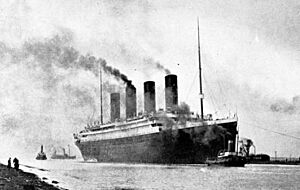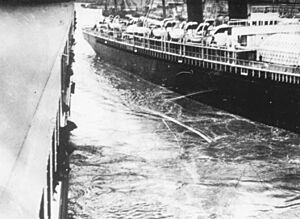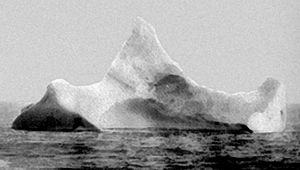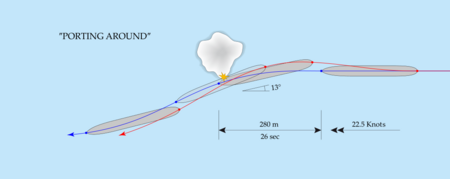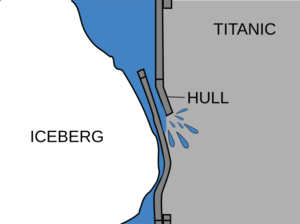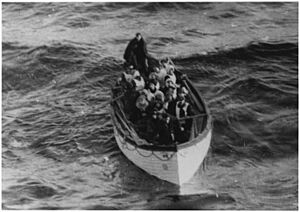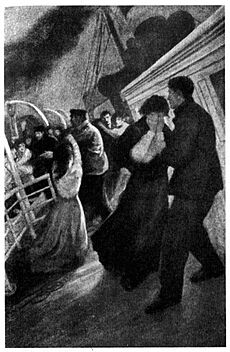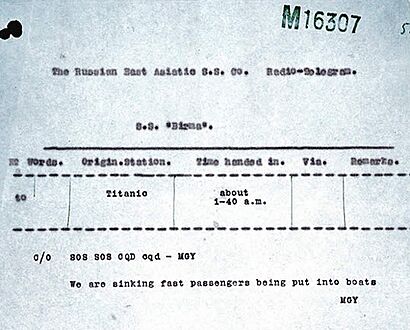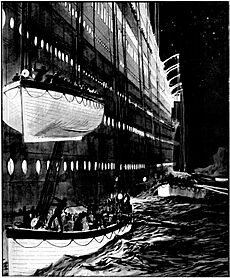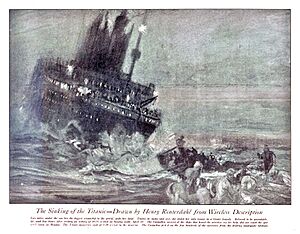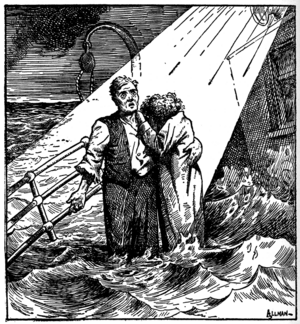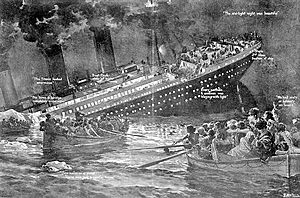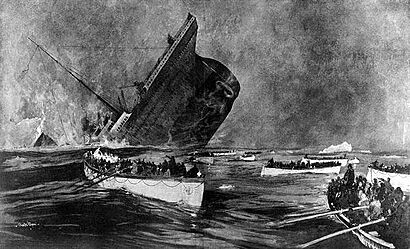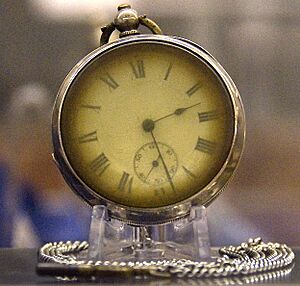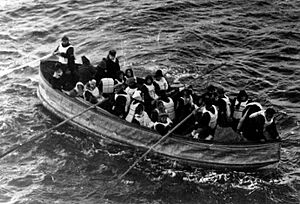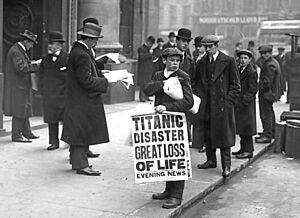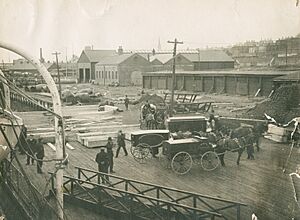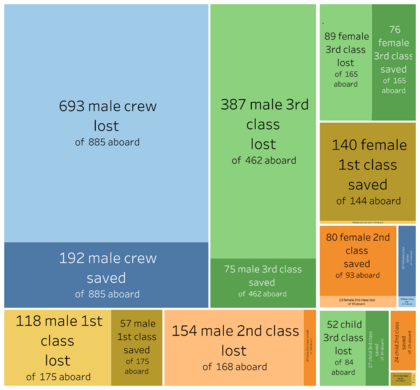Sinking of the Titanic facts for kids

The sinking of the Titanic as depicted in Untergang der Titanic, a 1912 illustration by Willy Stöwer
|
|
| Date | 14–15 April 1912 |
|---|---|
| Time | 23:40–02:20 (02:38–05:18 GMT) |
| Duration | 2 hours and 40 minutes |
| Location | North Atlantic Ocean, 370 miles (600 km) southeast of Newfoundland |
| Type | Maritime disaster |
| Cause | Collision with an iceberg on 14 April |
| Participants | Titanic crew and passengers |
| Outcome | Maritime policy changes; SOLAS |
| Deaths | 1,490–1,635 |
The RMS Titanic was a huge ocean liner. It sank on April 15, 1912, in the North Atlantic Ocean. This happened during its first trip from Southampton to New York City.
The Titanic was the biggest ship of its kind at the time. It had about 2,224 people on board. On April 14, at 11:40 PM (ship's time), it hit an iceberg. The ship sank two hours and forty minutes later, at 2:20 AM on April 15. More than 1,500 people died. This made it one of the deadliest peacetime ship disasters in history.
The Titanic received six warnings about ice on April 14. But it was still traveling very fast, at about 22 knots (41 km/h). The lookouts saw the iceberg too late. The ship could not turn fast enough. It scraped its starboard (right) side. This opened six of its sixteen compartments to the sea.
The Titanic was built to stay afloat even if four front compartments flooded. But with six open, it was in great danger. The crew sent out distress flares and radio messages for help. Passengers were put into lifeboats. The ship had only twenty lifeboats, not enough for everyone. Many boats were launched before they were full. This was due to poor planning and management.
Over a thousand people were still on board when the Titanic sank. Almost everyone who fell into the icy water died quickly. The RMS Carpathia arrived about 90 minutes after the sinking. It rescued 710 survivors by 9:15 AM on April 15. The disaster shocked the world. It led to big changes in rules for ship safety. This included the International Convention for the Safety of Life at Sea (SOLAS) in 1914. This convention still guides sea safety today.
Building and First Voyage
When the Titanic was finished on April 2, 1912, it was the second of three huge Olympic-class ocean liners. It was the largest ship in the world. It was much bigger than earlier record-holding ships. The Titanic could carry 3,547 people quickly and comfortably. Its engines were the biggest ever built. They were 40 feet (12 m) tall. They needed 600 long tons (610 t) of coal burned each day.
The passenger areas were very grand, especially for first class. The most expensive suites cost over $4,350 for a one-way trip. Even third class was more comfortable than usual for the time. Passengers had good food and better conditions than many had at home.
The Titanic began its first trip on April 10, 1912. It left Southampton for New York. Right after leaving, it almost crashed. Its huge size caused a nearby ship, the New York, to break its ropes. The New York swung towards the Titanic. A tugboat helped pull the New York away. Captain Edward Smith ordered the Titanics engines to go "full astern" (backwards). The ships missed each other by only 4 feet (1.2 m). This incident delayed the Titanics departure.
A few hours later, the Titanic stopped in Cherbourg Harbour in France. It took on more passengers there. Its next stop was Queenstown (now Cobh) in Ireland on April 11. It left that afternoon, heading west across the Atlantic.
The Titanic was carrying 892 crew members and 1,320 passengers. This was only about half its full capacity. Many people were not traveling because of a coal miners' strike. The passengers were from all parts of society. They ranged from rich people like John Jacob Astor IV to poor immigrants seeking a new life in the United States.
Captain Smith had 40 years of experience at sea. Most of the crew were not trained sailors. They were engineers, firemen, or stewards. Only a small part of the crew were able seamen. Many had just joined in Southampton and did not know the ship well.
The large amount of ice was due to a mild winter. This caused many icebergs to break off Greenland. A fire had started in one of the Titanic's coal bins about 10 days before it left. It burned for several days but was put out on April 13. The weather became very clear and calm by the evening of April 14.
Warnings and Collision
Iceberg Warnings
On April 14, 1912, Titanic's radio operators received six messages. These messages warned of icebergs. Passengers on the Titanic even started seeing ice during the afternoon. The ice conditions were the worst for April in 50 years. The radio operators did not pass on all these warnings. They worked for the Marconi Company, not the ship. Their main job was sending passenger messages. Weather reports were less important.
The first warning came at 9:00 AM. It reported "bergs, growlers" (small icebergs) and "field ice." Captain Smith got this message. At 1:42 PM, another ship, the Baltic, sent a report. It said it had been "passing icebergs and large quantities of field ice." Captain Smith also got this. He showed it to J. Bruce Ismay, the White Star Line chairman. Smith then ordered a new course, farther south.
At 1:45 PM, the German ship Amerika reported "two large icebergs." This message never reached Captain Smith or the officers. The reason is not clear. It might have been forgotten because the radio operators were fixing broken equipment.
The Californian reported "three large bergs" at 7:30 PM. At 9:40 PM, the Mesaba reported "much heavy pack ice and great number large icebergs." This message also stayed in the Titanic's radio room. The radio operator, Jack Phillips, was busy sending passenger messages. He might not have understood how important it was. A final warning came at 10:30 PM from the Californian. Its operator, Cyril Evans, had stopped for the night in an ice field. But Phillips cut him off, saying: "Shut up! Shut up! I'm working Cape Race."
Even with warnings, the crew did not slow down. The ship kept going at 22 knots (41 km/h; 25 mph). This was almost its top speed. Later, people said this was reckless. But it was normal practice then. Officers believed lookouts would see ice in time.
Ships like the Titanic focused on being on time. They often went at full speed. They treated ice warnings as advice, not orders to slow down. People thought ice was not a big risk. Other ships had hit icebergs and survived. In 1907, a German liner hit an iceberg and was damaged but finished its trip. That same year, Captain Smith said he could not "imagine any condition which would cause a ship to founder." He believed modern ships were too strong to sink.
"Iceberg, Right Ahead!"
Titanic Enters Iceberg Alley
As the Titanic neared the iceberg, most passengers were asleep. First Officer William McMaster Murdoch was in charge of the bridge. Lookouts Frederick Fleet and Reginald Lee were in the crow's nest, 29 metres (95 ft) above the deck. The air was freezing, and the ocean was perfectly calm. One survivor said, "the sea was like glass, so smooth that the stars were clearly reflected." This calm water can actually be a sign of nearby ice.
The air was clear, but there was no moon. The calm sea meant no waves broke against the icebergs, making them hard to see. The lookouts also did not have binoculars due to a mix-up. However, binoculars might not have helped in the total darkness. Still, the lookouts knew about the ice danger. They were told to "keep a sharp look-out for ice."
At 11:30 PM, Fleet and Lee saw a slight haze ahead. They did not think much of it. Some experts now believe this haze was a mirage. It was caused by cold water meeting warm air. This mirage would have made it harder to spot things far away.
The Collision
Nine minutes later, at 11:39 PM, Fleet saw an iceberg in the Titanic's path. He rang the lookout bell three times. He then called the bridge and told Sixth Officer James Moody, "Iceberg, right ahead!" Moody told Murdoch. Murdoch ordered Quartermaster Robert Hichens to turn the ship. Murdoch likely ordered "hard a-starboard." This would turn the ship to port (left). He also ordered the engines "full astern" (reverse).
There was a delay before the ship turned. The steering system took up to 30 seconds to move the rudder. Reversing the engines also took time. The center engine could not go in reverse. This made the rudder less effective. If Murdoch had just turned without reversing, the Titanic might have missed the iceberg.
The Titanic's direction changed just enough to avoid a head-on crash. But the ship scraped the iceberg with a glancing blow. An underwater part of the ice scraped along the starboard side for about seven seconds. Chunks of ice fell onto the front decks. About five minutes after the collision, all engines stopped. The ship slowly drifted south.
Damage from the Collision
For a long time, people thought the iceberg made a huge hole in the Titanic's hull. But modern scans of the wreck show the damage was much smaller. It was six narrow openings, totaling only about 12 to 13 square feet (1.1 to 1.2 m2). These gaps seem to have followed the lines where the hull plates were joined. This suggests that the iron rivets holding the plates together snapped or popped open. This created narrow cracks for water to flood in.
Some experts believe faults in the ship's hull contributed to the damage. Pieces of the Titanics hull plates found later seemed to have shattered on impact, not bent. The rivets in the front and back of the ship were made of a type of iron that might have been brittle, especially in extreme cold. However, the Olympic, Titanics sister ship, used the same rivets and served for 25 years without similar problems, even surviving other collisions.
Above the water, there was little sign of the collision. Many passengers felt a bump or shudder. One survivor said it felt "just as though we went over about a thousand marbles." But they did not know what had happened. Those on the lowest decks felt it more directly. A fireman heard a "heavy thud and grinding tearing sound."
Water began pouring into the ship right away. It came in at about 7 long tons (7.1 t) per second. This was 15 times faster than the pumps could remove it. Engineers and firemen worked to prevent the boilers from exploding. They were waist-deep in freezing water as they tried to vent the steam.
The Titanic's lower decks had 16 compartments. Each was separated by a watertight wall called a bulkhead. These bulkheads went up to E Deck, about 11 feet (3.4 m) above the waterline. The doors in these bulkheads could be sealed. Some could be closed from the bridge. Others were closed by hand.
Even though the bulkheads were high, they were not sealed at the top. If too many compartments flooded, the ship's front would sink deeper. Then water would spill over the top of the bulkheads into the next compartment. This is what happened. The Titanic was damaged in six compartments. It was designed to float with only two, or even the first four, compartments flooded. But with five or more breached, the ship would keep flooding.
Captain Smith felt the collision and came to the bridge. He called Thomas Andrews, the ship's builder. Andrews was on board for the first trip. The ship was already leaning to the right and down at the front. Smith and Andrews went below. They found the front cargo holds, mail room, and squash court flooded. Boiler room No. 6 was 14 feet (4.3 m) deep in water. Water was spilling into boiler room No. 5.
Within 45 minutes, 13,500 long tons (13,700 t) of water had entered the ship. This was far too much for the pumps. Andrews told the captain that the first five compartments were flooded. He said the Titanic would sink in about two hours.
From the collision until it sank, over 35,000 long tons (36,000 t) of water entered the Titanic. This almost doubled its weight. The flooding was not even. The ship first leaned to the right. Then it leaned to the left.
The ship's angle changed quickly at first. But then it slowed down. This gave many people false hope. By 1:30 AM, the front began sinking faster. By 2:15 AM, the ship's angle increased rapidly. Water poured into new areas. The Titanic disappeared from view at 2:20 AM.
Abandoning Ship
Preparing to Leave
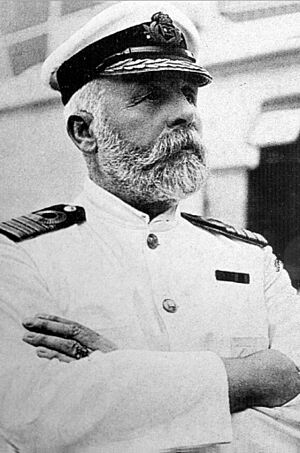
At 12:05 AM on April 15, Captain Smith ordered the lifeboats uncovered. He also told passengers to gather. Many passengers woke up because the engines had stopped. Below decks, water was rushing in. Mail sorters tried to save 400,000 mail items, but failed. Stewards went door to door, waking people. The Titanic did not have a public address system. They told everyone to go to the boat deck.
How well passengers were told depended on their class. First-class stewards helped passengers get dressed. Second and third-class stewards mostly just opened doors. They told people to put on lifebelts and go up. In third class, many were left to figure things out themselves. Many people did not want to leave. They did not believe the ship was sinking. They preferred the warm inside to the cold night. Passengers were not told the ship was sinking.
Around 12:15 AM, stewards told passengers to put on lifebelts. Some thought it was a joke. On the boat deck, preparing lifeboats was noisy. High-pressure steam escaped from the funnels. One survivor called it "a harsh, deafening boom." The noise was so loud that the crew used hand signals.
The Titanic had 20 lifeboats. Sixteen were wooden boats on davits (cranes). Four were collapsible boats with canvas sides. These had to be set up and moved. Two were under the wooden boats. Two were on top of the officers' quarters. These were very hard to launch. Each weighed several tons. On average, lifeboats held 68 people. In total, they could hold 1,178 people. This was barely half the people on board. It was only a third of the ship's licensed capacity.
The shortage of lifeboats was not due to cost. The Titanic was designed for 68 lifeboats, enough for everyone. But at the time, lifeboats were meant to transfer people to nearby rescue ships. It was common for liners to have fewer lifeboats than needed.
Captain Smith was a very experienced sailor. This was his first major crisis. He knew that over a thousand people would be left behind. Some people later said Smith was paralyzed by the situation. But survivors said he was calm and in charge. He investigated the damage and told the radio men to call for help. He ordered lifeboats prepared before Andrews told him the ship was sinking. Smith was seen helping load lifeboats and talking to passengers.
Fourth Officer Boxhall was told the ship would sink around 12:25 AM. But Quartermaster George Rowe was so unaware he called the bridge. He asked why he saw a lifeboat go by. The crew was not ready for an emergency. Lifeboat training was minimal. Only one drill happened in Southampton. It was a quick test with two boats. The boats were supposed to have emergency supplies. But they were only partly stocked. No drills had happened since the Titanic left Southampton. A drill planned for Sunday was canceled.
Lists assigned crew to lifeboat stations. But few seemed to have read them. Most crew were not sailors. Some had never even rowed a boat. They faced the complex task of lowering 20 boats with over 1,000 people 70 feet (21 m) down the ship's side. One historian said that even with enough lifeboats, they might not have launched them all. Indeed, not all lifeboats were launched before the ship sank.
By 12:20 AM, 40 minutes after the collision, lifeboat loading began. Second Officer Lightoller had to shout to Captain Smith over the steam noise. He asked, "Hadn't we better get the women and children into the boats, sir?" Smith nodded. He ordered Lightoller and Murdoch to "put the women and children in and lower away." Lightoller was in charge of the port side. Murdoch was on the starboard side. They understood the order differently. Murdoch allowed some men if all women and children were on board. Lightoller only allowed women and children.
Neither officer knew how many people the boats could safely hold. They were careful and did not fill them completely. They could have held 68 people each. If they had, 500 more people could have been saved. Instead, hundreds, mostly men, were left on board.
At first, few passengers wanted to get into the lifeboats. Officers found it hard to convince them. Millionaire John Jacob Astor IV said, "We are safer here than in that little boat." Some flat out refused. J. Bruce Ismay, seeing the urgency, urged people to board. A few women, couples, and single men got into starboard lifeboat No. 7. It was the first to be lowered.
Lifeboats Depart
At 12:45 AM, lifeboat No. 7 left with about 28 passengers. It could hold 65. Lifeboat No. 6, on the port side, was next at 12:55 AM. It also had 28 people, including Margaret "Molly" Brown. Lightoller realized there was only one sailor on board. He asked for volunteers. Major Arthur Godfrey Peuchen climbed down a rope. He was the only adult male passenger Lightoller allowed on the port side. This showed a problem: not enough sailors to row the boats. Some sailors sent below never returned. They were likely trapped by rising water.
Meanwhile, other crew members kept vital services running. Engineers and firemen vented steam from boilers. They reopened watertight doors to set up extra pumps. They kept the electrical generators running for lights and power. Two engineers died in boiler room No. 5 when a door collapsed. They were swept away by "a wave of green foam."
In boiler room No. 4, water started flooding in around 1:20 AM. This might mean the ship's bottom was also holed. The water quickly overwhelmed the pumps. Firemen had to leave. Further back, Chief Engineer Bell and his team stayed. They worked on boilers and generators. They kept lights and radio working. None of the 35 engineers or electricians survived. Neither did the five postal clerks. They were last seen trying to save mail bags.
Many third-class passengers saw water flooding their rooms. Carl Jansson, a survivor, recalled: "water with enormous force came into the cabin." He had to rush to the deck.
Lifeboats were lowered every few minutes. But most were very empty. No. 5 left with 41 people. No. 3 had 32. No. 8 left with 39. No. 1 left with just 12 out of 40. The evacuation had accidents. One woman fell between a lifeboat and the ship. She was pulled back and tried again. Annie Stengel had ribs broken when two men jumped into a boat.
The lifeboats' descent was also risky. No. 6 was almost flooded by water pumped from the ship. No. 13 nearly had the same problem. Its ropes got stuck. It drifted under No. 15, which was being lowered. The ropes were cut in time, and both boats got away.
By 1:20 AM, passengers knew the situation was serious. Husbands said goodbye to wives and children. Distress flares were fired. Radio operators sent distress calls. Radio operator Harold Bride suggested using the SOS signal. The RMS Carpathia was the closest ship, 58 miles (93 km) away. It was slower and would take four hours to arrive. The SS Mount Temple also headed for the Titanic but was stopped by ice.
The SS Californian was much closer. It had warned the Titanic of ice earlier. Its captain, Stanley Lord, stopped for the night in an ice field. At 11:30 PM, the Californians radio operator, Cyril Evans, went to bed. He shut down his radio. If he had stayed 15 minutes longer, hundreds of lives might have been saved. Later, the Californians Second Officer saw five white rockets. He told Captain Lord. But Lord did not act.
By this time, it was clear there were not enough lifeboats. Some still hoped. When Eloise Hughes Smith asked if her husband could go with her, Captain Smith ignored her. He shouted "women and children first." Lucian, her husband, told her, "It is only a matter of form to have women and children first. The ship is thoroughly equipped and everyone on her will be saved." Neither man survived.
Other couples refused to separate. Ida Straus told her husband, Isidor Straus: "Where you go, I go." They sat in deck chairs and waited. The rich man Benjamin Guggenheim changed into evening clothes. He said he wished to "go down like a gentleman."
Most passengers in lifeboats were from first and second class. Few third-class passengers made it to the deck. Many were lost in the ship's maze of corridors. Some were trapped behind gates. These gates separated third-class areas from first and second class. This was partly due to US immigration laws. These laws required segregation to control immigration and disease. Some crew members seemed to block third-class passengers. An Irish survivor wrote that sailors "fastened the doors and companionways leading up from the third-class section."
Third-class rooms were at the far ends of the lower decks. This was farthest from the lifeboats. First-class rooms were on upper decks, closest to the lifeboats. So, being close to lifeboats was key to survival. Many third-class passengers did not speak English. English-speaking Irish immigrants had a better chance. Some survived because a third-class steward, John Edward Hart, led groups to the boat deck. Others found open gates or climbed ladders.
Some passengers, overwhelmed, stayed in their cabins. Or they gathered to pray in the third-class dining room. One fireman saw crowds of third-class passengers with their bags. They seemed to be waiting for someone to tell them what to do. One survivor said many of his companions "had lost their own will power and expected God to do all the work for them."
Launching the Last Lifeboats
By 1:30 AM, the Titanic's angle was increasing. Messages from the ship showed the worsening situation. "Engine room getting flooded" at 1:35 AM. At 1:45 AM, "Engine room full up to boilers." This was the last clear signal. The ship's electrical system was failing. But the two radio operators kept sending distress messages.
The remaining boats were filled more fully. They were launched in a rush. No. 11 was overloaded. It was almost flooded by water pumped from the ship. No. 13 nearly had the same problem. Its ropes got stuck. It drifted under No. 15, which was being lowered. The ropes were cut in time, and both boats got away safely.
Panic started when men tried to rush port-side lifeboat No. 14. It was being lowered with 40 people. Fifth Officer Lowe, in charge, fired three warning shots into the air. No one was hurt. No. 16 was lowered five minutes later. Stewardess Violet Jessop was on board. She also survived the sinking of another Titanic sister ship, the Britannic, four years later. Collapsible boat C was launched at 1:40 AM. It was on this boat that J. Bruce Ismay, the White Star chairman, escaped. Many later called this act cowardly.
At 1:40 AM, lifeboat No. 2 was lowered. Lightoller found it full of men. He forced them out with an empty revolver. He could not find enough women and children. He lowered it with only 25 people. John Jacob Astor saw his wife off in No. 4 boat at 1:55 AM. But Lightoller refused him entry. There were 20 empty seats.
The last boat launched was collapsible D. It left at 2:05 AM with 25 people. Two more men jumped on as it was lowered. The water had reached the boat deck. First-class passenger Edith Evans gave up her place. She died in the disaster. She was one of only four first-class women to die.
Thomas Andrews was last seen in the first-class smoking room around 2:05 AM. He seemed to make no attempt to escape. Other reports say he helped with the evacuation. He was seen throwing deck chairs into the ocean for people to cling to. Captain Smith made a final tour of the deck. He told radio operators, "Now it's every man for himself." He told men launching Collapsible boat A, "Well boys, do your best for the women and children, and look out for yourselves." He returned to the bridge. Many believe he chose to go down with his ship. Some survivors saw him jump overboard.
Most passengers and crew went to the stern (back of the ship). The priest Thomas Byles heard confessions there. The Titanic's band played outside the gymnasium. The band had two groups of musicians. They had never played together before. After the collision, they played lively tunes. They later moved to the First Class Entrance.
It is a famous story that the band played the hymn "Nearer, My God, to Thee" as the ship sank. Some doubt this. But the story appeared early on. The hymn's opening notes are on the bandmaster's grave. One survivor, Archibald Gracie, denied it. Harold Bride said he heard ragtime, then "Autumn." George Orrell, bandmaster of the rescue ship Carpathia, said the band played "bright music, dance music, comic songs" to calm passengers. He said some passengers asked for hymns. "Nearer My God to Thee" was one that appealed to all.
Gracie said the tunes were "cheerful" but he did not recognize them. He said if they played the hymn, he would have noticed it. He would have seen it as a "tactless warning of immediate death." Several survivors said the band played until the final plunge. Gracie said the band stopped 30 minutes before the ship sank. Another passenger said the band threw down their instruments and left. The band might have stopped to get lifebelts, then resumed.
Bride heard the band as he left the radio cabin. It was filling with water. He saw a crewman trying to steal Phillips's lifebelt. Bride fought him. He wrote, "I did my duty. I hope I finished [the man]." The two radio operators went separate ways. Phillips died.
Gracie was also heading to the stern. But his path was blocked by "a mass of humanity." Hundreds of third-class passengers had finally reached the deck. But the last lifeboats were gone. He jumped into the water to get away from the crowd.
Final Moments of Sinking
Around 2:15 AM, the Titanic's angle increased quickly. Water poured into new parts of the ship. This caused a "giant wave" to wash along the deck. Many people were swept away. Those trying to launch collapsible boats A and B were also swept away. Boat B floated upside-down. Bride was trapped underneath it. Boat A was partly flooded. Bride and Gracie survived on boat B.
Lightoller, who tried to launch Collapsible B, dived overboard. He was sucked into a vent but blown clear by "a terrific blast of hot air." He landed next to the capsized lifeboat. The forward funnel collapsed. It crushed several people in the water. It narrowly missed Lightoller and the lifeboat. It created a wave that pushed the boat 50 yards (46 m) away from the sinking ship. Those still on the Titanic felt it shake. One passenger described it as a "rumbling roar, mixed with more muffled explosions."
Eyewitnesses saw the Titanic's stern (back) rise high into the air. It reached an angle of 30–45 degrees. Many survivors heard a loud noise. Some thought it was the boilers exploding. One survivor described it as "partly a groan, partly a rattle, and partly a smash." He thought it was engines and machinery breaking loose.
After another minute, the ship's lights flickered and went out. The Titanic was plunged into darkness. Passengers saw "groups of the fifteen hundred people still aboard, clinging in clusters or bunches." They fell as the ship's back rose into the sky.
Titanic's Final Plunge
The Titanic was pulled down by its flooded front. Air in the stern kept it up. This created huge forces. The ship split apart at a weak point near the engine room. The bow (front) may have stayed connected to the stern for a short time. It pulled the stern to a high angle before breaking off. The stern then floated for a few moments. It quickly flooded and sank. The ship disappeared from view at 2:20 AM, 2 hours and 40 minutes after hitting the iceberg.
Some survivors and official inquiries said the ship sank in one piece. But many other accounts suggested it broke in two. Since the engines stayed in place, the "great noise" was likely the ship breaking apart.
There are two main ideas about how the ship broke. The "top-down" theory says it broke first at the upper decks. Then the break went down to the bottom. The "Mengot theory" says it broke from the bottom up. In this idea, the bottom failed first.
After breaking, the bow and stern took about 5–6 minutes to sink 3,795 metres (12,451 ft). They left a trail of machinery, coal, and debris. The two parts landed about 600 metres (2,000 ft) apart on the seabed. The bow hit the seabed nose-first at about 25–30 mph (40–48 km/h). It dug deep into the mud. The stern fell almost straight down. It rotated as it fell. Empty tanks exploded, tearing open the structure. The stern landed with such force that it buried itself 15 metres (49 ft) deep. Debris continued to fall for hours.
People in the Water
After the sinking, hundreds of people were in the icy ocean. They were surrounded by debris. The ship breaking apart sent wood, furniture, and cork to the surface. Some of this debris may have hurt or killed swimmers. Others used it to stay afloat.
The water was −2 °C (28 °F), deadly cold. One survivor said it felt like "a thousand knives." Sudden cold water immersion causes death in minutes. This is usually from cardiac arrest or cold shock, not hypothermia. Almost everyone in the water died within 15–30 minutes. Only 13 were pulled into lifeboats, even though there was room for almost 500 more.
Those in the lifeboats were horrified. They heard screams of "human fear, despair, agony." One survivor compared it to "locusts on a summer night." Another described it as "a dismal moaning sound which I won't ever forget." The noise was a huge shock. Many in the lifeboats thought everyone had escaped.
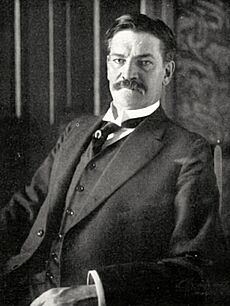
Only a few in the water survived. Gracie, Jack Thayer, and Lightoller reached the capsized collapsible boat B. About 12 crew members climbed on it. They rescued others until 35 men were clinging to the hull. They slowly paddled away. They ignored pleas from dozens of swimmers. Gracie admired those in the water. He heard men say, "All right boys, good luck and God bless you." Some survivors believed Captain Smith was in the water.
Other swimmers reached Collapsible boat A. It was upright but partly flooded. Its occupants sat for hours in freezing water. Many died of hypothermia.
The other 18 lifeboats, most with empty seats, drifted. Occupants debated helping swimmers. Boat No. 4 was closest. It picked up three people from the water. Seven more men were pulled from the water after the sinking, though two later died. Collapsible D rescued one male passenger. In other boats, people decided not to return. They feared capsizing. One officer said there were "only a lot of stiffs there."
After about 20 minutes, the cries faded. Swimmers lost consciousness and died. Fifth Officer Lowe waited until the screams stopped. He gathered five lifeboats. He moved people between them to make space in No. 14. Lowe then took seven crewmen and one volunteer passenger. They rowed back to the sinking site. This took about 45 minutes. By then, almost everyone in the water was dead. Only a few voices were heard.
One survivor recalled the last cry: "My God! My God!" He cried "monotonously, in a dull, hopeless way." After an hour of shrieks, there was silence. For some, the silence was worse than the cries. Lowe found four men alive. One died soon after.
In other boats, survivors waited for rescue. The air was bitterly cold. Several boats had taken on water. There was no food or drinkable water. Most had no lights. Collapsible B was in trouble. It stayed afloat by a shrinking air pocket. As dawn neared, the wind rose. The sea became choppy. Those on the capsized boat had to stand to balance it. Some fell into the sea and drowned.
Rescue and Arrival
The Titanics survivors were rescued around 4:00 AM on April 15. The RMS Carpathia arrived. It had steamed through the night at high speed. It dodged many icebergs. Carpathias lights were first seen around 3:30 AM. This cheered survivors. But it took hours to get everyone aboard. The 30 men on collapsible B finally boarded two other lifeboats. Collapsible A was also nearly sinking. Many aboard had died overnight. The remaining survivors were moved. Three bodies were left in boat A. It was found a month later.
Those on the Carpathia were surprised by the scene at sunrise. They saw "fields of ice" and "innumerable pyramids of ice." Captain Arthur Rostron saw 20 large icebergs, 200 feet (61 m) high. There were also smaller bergs and debris from the Titanic.
Survivors came aboard the Carpathia in different ways. Some climbed rope ladders. Children were hoisted in mail sacks. The last lifeboat, Lightoller's No. 12, reached the ship at 9:00 AM. It had 74 people, though it was for 65. There were joyful reunions. But many hopes died as loved ones did not appear.
At 9:15 AM, two more ships arrived: the Mount Temple and the Californian. The Californian's radio operator had finally returned to duty. But by then, there were no more survivors. The Carpathia was going to Fiume (now Rijeka). But it did not have enough supplies or medical care for the survivors. Rostron ordered a return to New York. The Carpathia left the area. The other ships searched for two more fruitless hours.
Aftermath and Impact
Sadness and Anger
The Carpathia arrived in New York on the evening of April 18. It was a difficult trip through ice, fog, and storms. About 40,000 people waited at the docks. They knew about the disaster from radio messages. Only after the Carpathia docked did the full scale of the disaster become known.
Even before the Carpathia arrived, efforts began to find the dead. Four ships hired by the White Star Line found 328 bodies. 119 were buried at sea. The other 209 were brought to Halifax, Nova Scotia. 150 of them were buried there. Memorials were built in many places. Ceremonies were held to remember the dead and help survivors. Most of the Titanic's victims' bodies were never found.
People reacted with shock and anger. They asked: Why so few lifeboats? Why did Ismay save himself? Why did the Titanic go so fast into the ice? Survivors themselves helped fuel this anger. They wrote a letter to The Times newspaper. They urged changes to sea safety laws.
In places linked to the Titanic, grief was deep. Southampton, home to 699 crew members, suffered the most. Crowds of weeping women gathered outside White Star offices. Most of them were among the 549 Southampton residents who died. In Belfast, where the ship was built, shipyard workers cried. The ship was a symbol of their city's achievements. There was grief and guilt.
In Liverpool, the White Star Line's home, public anger was so strong. Company representatives had to announce the list of dead from their headquarters balcony.
Inquiries and New Rules
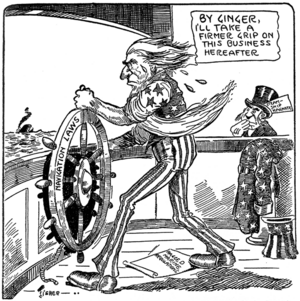
After the sinking, the United Kingdom and United States held public investigations. The US inquiry began on April 19. The British inquiry started on May 2. They both found similar things. Rules for lifeboats were old and not enough. Captain Smith did not pay enough attention to ice warnings. Lifeboats were not filled or crewed properly. The collision happened because the ship went too fast into a danger area. Both inquiries strongly criticized Captain Lord of the Californian for not helping the Titanic.
Neither inquiry found the White Star Line at fault. The US inquiry said those involved followed normal practice. They called the disaster an "act of God" (an unavoidable event). The British inquiry said Smith followed old practices that were not known to be unsafe. It noted that British ships had carried millions of passengers with few deaths. But it warned that what was a mistake for the Titanic would be seen as carelessness in the future.
The disaster led to big changes in sea rules. More lifeboats were required. Lifeboat drills had to be done correctly. Ship radios had to be staffed all the time. Radio operators had to prioritize emergency messages. An International Ice Patrol was set up to watch for icebergs. Sea safety rules were made the same worldwide through the International Convention for the Safety of Life at Sea (SOLAS).
Cultural Impact and Wreckage
The Titanic's sinking became a huge cultural event. Artists, filmmakers, writers, and musicians have remembered it. On September 1, 1985, an expedition led by Robert Ballard found the wreck of the Titanic. This discovery sparked huge interest. Many trips have been made to film the wreck. Objects have been brought up from the debris field. The first big exhibit of these items was in London in 1994–95. The disaster inspired many films. James Cameron's 1997 film Titanic was the first film to earn $1 billion. It won 11 Academy Awards.
The wreck is slowly decaying. Metal is turning to rust. Eventually, the Titanic's structure will collapse. It will become a patch of rust on the seabed. Only stronger parts like propellers and compasses will remain.
Who Survived and Who Was Lost
The exact number of deaths is unclear. This is because of confusion over passenger lists. Some people canceled their trip. Others used fake names. The death toll is estimated between 1,490 and 1,635 people. The numbers below are from the British Board of Trade report.
| Passengers | Category | Number onboard |
Percentage by total onboard |
Number saved |
Number lost |
Percentage saved |
Percentage lost |
Percentage saved by total onboard |
Percentage lost by total onboard |
|---|---|---|---|---|---|---|---|---|---|
| Children | First Class | 6 | 0.3% | 5 | 1 | 83% | 17% | 0.2% | < 0.1% |
| Second Class | 24 | 1.1% | 24 | 0 | 100% | 0% | 1.1% | 0% | |
| Third Class | 79 | 3.6% | 27 | 52 | 34% | 66% | 1.2% | 2.4% | |
| Total | 109 | 5% | 56 | 53 | 51% | 49% | 2.5% | 2.4% | |
| Women | First Class | 144 | 6.5% | 140 | 4 | 97% | 3% | 6.3% | 0.2% |
| Second Class | 93 | 4.2% | 80 | 13 | 86% | 14% | 3.6% | 0.6% | |
| Third Class | 165 | 7.4% | 76 | 89 | 46% | 54% | 3.4% | 4.0% | |
| Crew | 23 | 1.0% | 20 | 3 | 87% | 13% | 0.9% | 0.1% | |
| Total | 425 | 19.1% | 316 | 109 | 74% | 26% | 14.2% | 4.9% | |
| Men | First Class | 175 | 7.9% | 57 | 118 | 33% | 67% | 2.6% | 5.3% |
| Second Class | 168 | 7.6% | 14 | 154 | 8% | 92% | 0.6% | 6.9% | |
| Third Class | 462 | 20.8% | 75 | 387 | 16% | 84% | 3.3% | 17.4% | |
| Crew | 885 | 39.8% | 192 | 693 | 22% | 78% | 8.6% | 31.2% | |
| Total | 1,690 | 75.9% | 338 | 1,352 | 20% | 80% | 15.2% | 60.8% | |
| Total | All | 2,224 | 100% | 710 | 1,514 | 32% | 68% | 31.9% | 68.1% |
Less than a third of those on the Titanic survived. Some survivors died soon after. Injuries and cold caused deaths on the Carpathia. Of the groups in the table, 49% of children died. 26% of female passengers died. 82% of male passengers died. 78% of the crew died.
The survival rates were very different for men and women, and for different classes. Less than 10% of first- and second-class women died. But 54% of third-class women died. Five of six first-class children survived. All second-class children survived. But 52 of 79 third-class children died. The only first-class child to die was Loraine Allison, aged two. Second-class men had the highest losses, with 92% dying. Of the pets on board, three survived.
See also
 In Spanish: Hundimiento del RMS Titanic para niños
In Spanish: Hundimiento del RMS Titanic para niños


